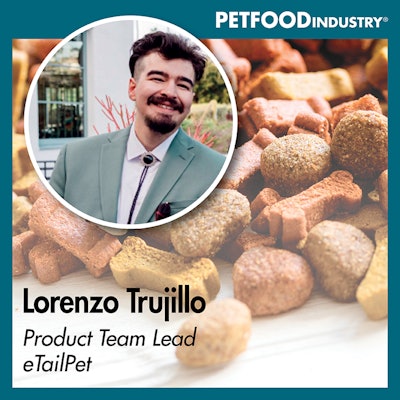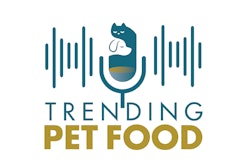
Host Lindsay Beaton, editor of Petfood Industry, talks with Lorenzo Trujillo of eTailPet to find the answer to the question, "What are the latest and greatest in digital technologies for pet retailers?"
The below transcript is from Episode 50 of the Trending: Pet Food podcast, where editor Lindsay Beaton speaks with product team lead for eTailPet, Lorenzo Trujillo. Together they delve into the latest digital technologies and explore what pet retailers need to run their businesses more efficiently. You can find the episode at PetfoodIndustry.com/trending-pet-food-podcast, on SoundCloud or on your favorite podcast platform. This episode originally aired on December 6, 2023.
Lindsay Beaton, editor, Petfood Industry magazine and host, Trending: Pet Food podcast: Hello and welcome to Trending: Pet Food, the industry podcast where we cover all the latest hot topics and trends in pet food. I'm your host and editor of Petfood Industry Magazine, Lindsay Beaton. I'm here today with Lorenzo Trujillo, product team lead at eTailPet. Hi, Lorenzo and welcome.
Lorenzo Trujillo, product team lead for eTailPet: Hello, thank you for having me here today.
Beaton: In case you're not familiar with Lorenzo or eTailPet, here's what you need to know. With a passion for the pet industry and a deep commitment to the success of independent businesses, Lorenzo is dedicated four transformative years to eTailPet. His journey at the company began in webpage design, where he harnessed his creativity and technical skills to craft captivating online experiences.
He progressed into a leadership role as the product team lead overseeing the development and optimization of eTailPet’s product offerings. As a proud pet parent to two small dogs, Bogart and Boo Billy, Lorenzo fully understands the unique needs and desires of both pet parents and retailers and the importance of providing exceptional products and services in the pet industry.
eTailPet was founded by independent pet store owner Bernice Giannini and is the only full-service solution created for pet businesses by a pet business owner. eTailPet’s point-of-sale system unites inventory management online selling tools and marketing into one place.
Lorenzo has extensive experience with digital technology and pet food retail are why I've brought him on today to answer this question: What are the latest and greatest in digital technologies for pet retailers?
There is a lot that we could be talking about when we talk about technologies. I want to start off by narrowing in what types of technologies we're going to be talking about today. What kind of technology are we talking about when we discuss retail technologies in general, and then specifically the ones that are used in pet food retail?
Trujillo: When you're just talking about the retail space, in general, you hear this term: POS, which stands for point-of-sale software, which in any type of retail space is almost necessity when it comes to cutting down on workflow times and managing day-to-day business inventory, reporting, things of that nature.
Within the pet space – I believe this is a 2022 statistic, I can't speak to it exactly – but in your pet retail industry, 50% of that is local pet or independent pet and the other 50% is enterprise and/or big box stores.
You will find a lot of the time with that 50% local pet market, there are a lot of folks that aren't even using point-of-sale technology. You have folks that spend an obscene amount of time for things that with point-of-sale software accounting for things like your inventory and keeping a real-time sync of when you sell a product at the register and then reconciling that inventory in the backend of your system so you have up-to-date inventory in your backend, and you can know, “oh, I have this much on hand.”
Within the pet space, you find a lot of folks that are independent pet, they are not utilizing any type of software that you would expect a retail location to use. For example, point-of-sale, some type of e-commerce presence as well, like that's standard nowadays. If you're selling a product, you want to have some type of web presence. I don't have the specific number, but it's up over 90% of purchases that come into the store are usually done through a local search first, before the customer comes into the store.
What is a local search? As we all kind of do on our day to day, if we're looking for a product and we want it that day, we'll go on our phone and search “dog food closest to me” and boom – you have your Petcos, you have your big box stores, but also you have your independent stores that will also show up in those local search results depending if they're leveraging that type of technology such as e-commerce and a little sprinkle SEO, which stands for search engine optimization technologies. SEO products, what they do is essentially push your search results higher in the search engine when locally searched by the user.
So just by simply doing something as having an SEO with an e-commerce product, where you're actively pulling in reviews from your users, will put you within the search results higher than a big box store because you're actively getting that data and feeding it into your site while you're selling products, which is really a big thing when you're an independent pet store and you're trying to compete with these bigger brands out there.
One, just having the visibility will bring that business into your store. Going back to what I was saying before, within the independent pet space, you find a lot of folks are not leveraging any type of technology, therefore, they're missing out on a lot of sales and revenue opportunities.
Simply just enrolling yourself into a tool that can cut down your workflow time by over 40 hours in a week on average and giving you a web presence that you're not even aware. Simply enrolling yourself into some type of e-commerce or SEO technology, you'll organically grow your business without even having to really do anything, just going through those setup processes.
With standard retail things, what we typically see is point-of-sale software and e-commerce presence or some kind of web presence. Within the pet space, specifically, what's becoming more of a need, grooming and boarding services are in need. In the United States, we don’t have enough folks that can perform pet services such as grooming and boarding. With that, you also need a software that can run into your POS system or whatever you're using seamlessly with your day-to-day activities.
Typically, your big two, that you need, I think is just a requirement for any type of retail location, pet or not, you need to have a point-of-sale and you need to have an e-commerce software. That is typically what is utilized. As mentioned before, in our space, there's a lot of folks that don't, so there's such an opportunity there just to help those folks grow their presence within their local communities and their local market.
Beaton: I thought point-of-sale was pretty standard in terms of owning a retail business. What are some of the reasons that you've heard that people are not using these technologies? Are they still doing it manually? Is it strictly financial? Is it kind of a fear of integrating a technology they're not familiar with? If they're particularly small business and maybe there's only one or two people, is it a time constraint for training? What are some of the pushbacks against implementing these kinds of technologies? It sounds like the technologies themselves would be huge timesavers once they're implemented, and once you know how to use them.
Trujillo: It's definitely a mixture of all of those things, especially if you're talking to someone that has never used a POS before. Within the pet space, more often than not, when I talk to folks that onboard to our system that have never had a POS before, it's just because they bought the business 15 to 20 years ago, it was inherited from their parents and/or was purchased from the original owner who never had a POS, so they just proceeded with how the owner trained them to run the business.
When you come to a user and say, “Hey, we have this product that basically can make your dreams come true.” It's a little like, oh, what's the catch, right? Which definitely holds folks back. I think most often, it's just understanding what this product is going to do for you. What is your buy-in to this product? How much are you really going to be involved? Is this really going to make your life easier? Is this really going to improve your business? Is this going to grow your sales? It's a gamble they must take on their part. It's really, especially in eTailPet’s regard, it's our job to arm the user with as much information as possible to let them know, hey, for every scenario you presented to us, this is how things work.
That's another part of this whole equation. Folks have their own workflows to things. It's always a looming question with software in general – how do you create something that fits the whole of the market? How do you create a workflow that works for everyone? That works for most instances – basically just looking to benefit the whole with your investment on development with your product.
Going back to this potential user, they may have a way they've done things for 15 to 20 years, and we built our product to be as standard to our industry or our vertical as possible, so it can fit all scenarios. These folks may do things far outside that norm. It's also a conversation of like, “Oh, I see you do things this way. Well, if you were to do it this way, and this is how it works within the system for these seven reasons, this will work better for you.”
That is the whole conversation -- just trying to just give that person the comfort of when I go into this thing, I know what's going to happen. I know what it can do. I understand its capabilities to run my business in the future.
To go back to your original question, really what holds people back I think is that going from running your business one way for so many years then one, you have to spend the money to utilize the software and possibly invest into some hardware to be able to run it. Two, you're going to have to prepare to move your business's workflow over. If it is drastically different, you must prepare to work within the workflow of that system. If you can help that user understand why that workflow either works better or -- and this kind of is what's awesome for us – maybe there are things that we haven't thought of that we haven't covered that we can learn from those situations as well.
Beaton: What has it been like integrating ecommerce-type technologies? Obviously, there's been a big boom for a while, but especially in the last few years, when all of a sudden omnichannel shopping exploded due to the pandemic and due to trends that were already happening anyway. Are you finding that to be a separate challenge with people? Or are people doing the one-two punch trying to upgrade everything at once if they haven't been upgraded before? What kind of lessons have you learned in terms of what pet needs when it comes to e-commerce and what it's been like for retailers to try to implement an omnichannel strategy, essentially?
Trujillo: It’s been smooth on our part because we started out as an e-commerce-only product, and then we built a POS software within it. It's been seamless in terms of just integrating an e-commerce solution with our products, since it was already built before the POS actually was. Luckily, at that time, when I had first arrived here at eTailPet, we were only e-commerce and we had built that out first to help our independent retailers get a web presence and be out there.
As we all know, COVID was ongoing during that time. So curbside delivery and home deliveries blew up and shipping from the store blew up during that time. We focused our efforts to get a fully built-out e-commerce solution. We could give independent pet a tool to be able to get their business out there and want to facilitate sales through it and be able to reach their customers and get their products not just through the store, which was great.
Then it just worked out when we moved into the POS software, because we were able to integrate it directly into the e-commerce. Now, not only do you have the e-commerce solution where you're already displaying products and pricing, well, you have your POS, which is utilizing the same products, the same system, but now you can manage your inventory within it.
Now, “oh, I'm worried if I have this product online, I have only 10 of them, and I don't want someone to buy 13.” Well, now with the POS, it knows. “Oh, you only have 10 products, so only 10 can be purchased at this moment.” Or, if a product is sold in store, you only have nine. Okay, only nine can be purchased online.
You get that omnichannel sync. In store operations, we're selling products in-store. Then, from the same exact login, same dashboard, you can manage how your e-commerce is functioning. You can manage things like your content pages, how your landing page looks, your products, your current price slashes and/or promos that you're running.
It's been a really, really streamlined experience. For the folks that we've had that initially jumped on as e-com, we had a lot of them jump over to the POS. We have the streamline synchronicity of having three products all fused together – that being our e-commerce platform, our POS platform and our scheduling and booking platform – all lives in the same domain. They all talk to each other and present this awesome experience where you receive a sale online from your POS, you can see, “oh, I just got an online order. Let me go look at that right from in store.” It's just such a seamless experience.
Beaton: Since we're already kind of touching on them as we're having the conversation, I want to do a little bit of a deeper dive into challenges that you're hearing from retailers in terms of their technology. Are there a few things that always seem to get people that you end up providing solutions for repeatedly or have there been any evolving challenges as omnichannel has become more prevalent, and people are looking to stay competitive and be more mindful about their inventory? Especially with supply chain issues and things like that?
Trujillo: Definitely, in terms of challenges. This is eTailPets’ bread and butter, it's our catalog. We have a master catalog that we update every day of over 200,000 products are given the information comes directly from the manufacturers or distributors, where we will go ahead and create the product with an image with a description, guaranteed analysis info, ingredients -- whatever we are provided. So that takes that whole step of new repack came out. As we know within the pet industry, we have a lot of repacks that happen where a particular wet dog food can is a UPC this month and two weeks later, it has another UPC with a different packaging. It can be very hard to keep up with that, especially as an independent retailer where you don't necessarily have time to go and grab these images and go and get all this information and keep your catalog as up to date as possible.
That's really where we come in and make your life easy. All you need to do is have a UPC with you and you can click one button add that product to your catalogue choose whether you want to display it on your website and then you can go from there. You can give it a price slash, you can give it discounts, anything typical with the products, you can do.
Going back to a big pain point it is the catalog. A big thing is kind of what I was talking about earlier with the synchronicity of having multiple, technically different software products in one space. Having a POS and e-comm is a big deal to a lot of people. The reason is a lot of folks will have an e-commerce site and they'll have a POS site that don't have an inventory sync. Anytime they make a website sale, they must go in and manage their POS inventory to match that, so they don't oversell any products. That, in and of itself, is a job for someone. That is a whole job that you can spend the entire day doing. When pet retail does a lot of volume, they sell a lot of pet food, a lot of hard goods, that's not necessarily a realistic expectation to have.
A really big thing is rewards. We are the only POS out there that offers a native Astral integration within the pet space. Astral Loyalty is a very, very big entity and a partner to us. A lot of folks utilize their rewards in their stores. It's wonderful when folks come in and they realize that our system is completely integrated with that platform.
Typically, anytime you are participating with an Astra Loyalty, you must manually manage the rewards outside of your POS. It's another huge pain point that folks come in with and it just makes their lives a lot easier. “Oh, a customer comes in and they bought 20 bags, they have three punch cards, I got punched out, I don't have to sit here for 30 minutes and punch those cards out. The system will go ahead and do it for me.”
In general, just taking a lot of what manual process would be taking that whole part away and just having the system do it for you. And knowing they can do it for you. Because it's going to tell you that it did retailer feeling like they must do a lot of things manually, they still must manage a lot of things even though they are using a platform. It kind of defeats the purpose of having it. That's what folks are coming to us for is their platform is not doing what it needs to do – maybe it's not because of the platform, maybe it's because what they're using.
We find this a lot too: we have a lot of folks that may be using a platform that it's not for a pet space. It doesn't really fit exactly like what they would be doing day to day. Also, if they are, they may be using one POS system, one e-commerce system and one booking system. They don't want to pay for all three of those and don't want to have to spend the time to navigate between the three. They'd rather have a centralized system where it can do it all.
Beaton: Let's talk about the multiple technological needs for a minute, because there are a lot of retailers in the pet space, who are independent, they're local, they're the only store they're not part of a chain, they're not part of a franchise, they're on a budget.
What would you recommend if they're listening to this episode? What should be their first technological jump if they're doing everything manually? If they can only do one thing, what have you found makes the biggest difference technology wise for retailers in terms of organization and time management, and all the things that small stores really need help with but don't have big budgets for?
Trujillo: The key place is do not start with any local-based system. Please go with a cloud-based system. One, the initial startup cost is going to be significantly lower, because you will only need to buy the hardware that it takes to run a cloud-based system rather than a local system, it's going to be significantly more. If you have instances where you go home and, “Oh, I forgot to check in a PO or I forgot to do something with the cloud-based system,” you can login right from your laptop and do whatever you need to do, then have that peace of mind.
If you have no system – you have nothing, you’re doing everything by hand – please start with looking at a cloud-based software.
The thing is, if you are doing everything manually, it's hard to keep a legitimate record with timestamps and date histories to refer to in the event anything goes wrong. It's going to take significantly longer to go back and find these mistakes if you are doing these things manually. This is just talking about reporting. For example, an inventory account is wrong, it's going to be very hard to go back and check either written on a barcode sheet that was received from the delivery or written down on a piece of paper somewhere. That's not really a good way to look at things because it could also not be a factual standpoint because that number or what you're referencing could not be what is now and when you are using a system that is active and it is living and breathing and you're running your business through it, you have the safety net of knowing this is where my sales are going. This is where my inventory is. This is what my reporting looks like. This is the current customer list I have.
You get so much more information that is valuable and that you can use to drive your business by simply -- even before starting with the e-commerce presence -- please get a POS. You need the POS to be able to help take you to that next step at your business because it's going to give you the data points to help give you the information to make those decisions for the next step of your business.
That could just be something as simple as this item is selling incredibly well during these time periods of the year, and I'm going to order more around this time. The system is arming you with this information to make decisions to benefit your business. And that's really what you need instead of having to sit there and figure out all that information yourself, which could take hours and hours on end. Why not just have the system do it for you at a low cost?
Cloud-based systems are typically a couple $1,000 a year, and you can spend that couple $1,000 and save probably thousands of hours and time to have accurate record keeping. Also, it will allow you to have more data to improve and expand your business. You'll have sales information, trending non-seller's reports or customer reports. You can see the customers who are purchasing the most products, then you can further expand on that once you have that solid foundation of understanding of what's going on within your business. You will have a model that can track it and tell you what's going on, then you expand it into the e-commerce then really start growing your business.
If you're starting from ground one, please get a POS system that is cloud based. That is going to be the best thing you can do for your business and for your wallet.
Beaton: We've talked about growth and evolution in technologies. It sounds like people need more and more or are looking for more and more just to keep up in this space. Time management is always a huge thing. We're coming up on the end of the year, so I always like to ask, what is coming? What do you see in terms of these technologies in 2024? Is there anything new that's happening? Is it going to be more usage of what there is right now? What are some of the things you're expecting to tackle next year?
Trujillo: Next year, I think the largest thing is going to be being able to facilitate greater options to do shipping from the store … allowing to sell products with other methods other than store pickup, so the users can one broaden their market space. A lot of folks, especially with our users, have shared a lot of interest in improving how shipping from store works; further expanding upon that and giving it more functionality to where you can really have a robust, almost standalone shipping platform.
I think next year that's going to be a real big driver for us – figuring out how we can facilitate multiple methods of shipping. Within that the caveats of charging different tax rates for certain regions and all the different nuances that come with shipping from the store. I think that's going to be a really big thing going into next year.
Another big thing for us that we are going to be working on specifically for eTailPet is implementing a product review system, so we can have a shared database of reviews that will filter product reviews to the customer facing side of the e-commerce platform just to give it that extra layer of depth. This can arm the retailer's customers with more information to help them make buying decisions, like, as we all know, most of us do when we buy a product. We usually look at which one has the highest review if there's multiple offerings of that same type of product. We'll pick the highest review with the most purchases. A lot of folks that are current users would greatly desire that functionality. It's probably our most number one requested thing we have. That will be a big focus going into next year as well.
Another big thing is just looking into different types of integrations with your software with rewards programs. This is a really big thing with the pet space -- rewards programs. You really, really need them and having good options out there. We're probably going to see more of those pop-up next year to compete with whoever's in the space currently.
Grooming and scheduling – that is just an ever-growing industry. It's just going to continue to grow. You can expect that there is going to be a lot more software, either existing software or softwares pop up that are scheduling focused or pet-services focused. That's something to look out for. You would be surprised, there are many out there but not as many as you would think. That will be a big thing. That industry is huge. It has only grown since 2019 when COVID hit. Pet parent ownership went up significantly during that timeframe. With more pets, you need more folks to groom them. In 2023, we're seeing where a lot of groomers are overbooked. I talked to the groomers every day, and nine out of 10 times, they are overbooked, and they're booked up for the rest of the year. Expect more alternatives and solutions coming for that space in the following year, 100%.
Beaton: Well, thank you so much for coming on and breaking all of that down for me and for my retail audience. There's so much going on in technology is playing such a huge role in all of this. I think it can be hard to keep up with what solutions are out there or be able to verbalize what you even need in terms of something that technology could provide. I really appreciate you being on to help break some of that stuff down and hopefully give some insights to people.
Trujillo: Not a problem. I'm happy to help.
Beaton: Before we go, let's do a little plug. Where can people find more information about you and eTailPet?
Trujillo: You can find more information about eTailPet at eTailPet.com. And if you want to find out more information about me, you can see me on LinkedIn.
Beaton: Thank you so much. That’s it for this episode of Trending: Pet Food. You can find us on PetfoodIndustry.com, SoundCloud or your favorite podcast platform. You can also follow us on Instagram @trendingpetfoodpodcast. And if you want to chat or have any feedback, I'd love to hear from you. Feel free to drop me an email: [email protected].
Once again, I'm Lindsay Beaton, your host and editor of Pet Food Industry magazine. We'll talk to you next time. Thanks for tuning in!

















